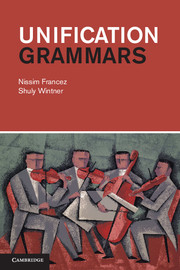29 results
Do more proficient writers use fewer cognates in L2? A computational approach
-
- Journal:
- Bilingualism: Language and Cognition / Volume 27 / Issue 1 / January 2024
- Published online by Cambridge University Press:
- 05 October 2023, pp. 84-94
-
- Article
-
- You have access
- Open access
- HTML
- Export citation
Representing argument structure1
-
- Journal:
- Journal of Linguistics / Volume 53 / Issue 4 / 10 November 2017
- Published online by Cambridge University Press:
- 05 July 2016, pp. 701-750
- Print publication:
- 10 November 2017
-
- Article
- Export citation
Computational evaluation of the Traceback Method
-
- Journal:
- Journal of Child Language / Volume 41 / Issue 1 / January 2014
- Published online by Cambridge University Press:
- 24 January 2013, pp. 176-199
-
- Article
-
- You have access
- Open access
- HTML
- Export citation
Morphological disambiguation of Hebrew: a case study in classifier combination
-
- Journal:
- Natural Language Engineering / Volume 20 / Issue 1 / January 2014
- Published online by Cambridge University Press:
- 26 July 2012, pp. 69-97
-
- Article
- Export citation
Extraction of multi-word expressions from small parallel corpora
-
- Journal:
- Natural Language Engineering / Volume 18 / Issue 4 / October 2012
- Published online by Cambridge University Press:
- 21 March 2012, pp. 549-573
-
- Article
- Export citation
7 - Conclusion
-
- Book:
- Unification Grammars
- Published online:
- 25 October 2011
- Print publication:
- 30 September 2011, pp 275-276
-
- Chapter
- Export citation
Index
-
- Book:
- Unification Grammars
- Published online:
- 25 October 2011
- Print publication:
- 30 September 2011, pp 307-312
-
- Chapter
- Export citation

Unification Grammars
-
- Published online:
- 25 October 2011
- Print publication:
- 30 September 2011
6 - Computational aspects of unification grammars
-
- Book:
- Unification Grammars
- Published online:
- 25 October 2011
- Print publication:
- 30 September 2011, pp 213-274
-
- Chapter
- Export citation
Appendix A - List of symbols
-
- Book:
- Unification Grammars
- Published online:
- 25 October 2011
- Print publication:
- 30 September 2011, pp 277-279
-
- Chapter
- Export citation
Appendix C - Solutions to selected exercises
-
- Book:
- Unification Grammars
- Published online:
- 25 October 2011
- Print publication:
- 30 September 2011, pp 284-298
-
- Chapter
- Export citation
2 - Feature structures
-
- Book:
- Unification Grammars
- Published online:
- 25 October 2011
- Print publication:
- 30 September 2011, pp 34-84
-
- Chapter
- Export citation
Contents
-
- Book:
- Unification Grammars
- Published online:
- 25 October 2011
- Print publication:
- 30 September 2011, pp vii-viii
-
- Chapter
- Export citation
Preface
-
- Book:
- Unification Grammars
- Published online:
- 25 October 2011
- Print publication:
- 30 September 2011, pp ix-xi
-
- Chapter
- Export citation
4 - Unification grammars
-
- Book:
- Unification Grammars
- Published online:
- 25 October 2011
- Print publication:
- 30 September 2011, pp 115-164
-
- Chapter
- Export citation
3 - Unification
-
- Book:
- Unification Grammars
- Published online:
- 25 October 2011
- Print publication:
- 30 September 2011, pp 85-114
-
- Chapter
- Export citation
Acknowledgments
-
- Book:
- Unification Grammars
- Published online:
- 25 October 2011
- Print publication:
- 30 September 2011, pp xii-xii
-
- Chapter
- Export citation
1 - Introduction
-
- Book:
- Unification Grammars
- Published online:
- 25 October 2011
- Print publication:
- 30 September 2011, pp 1-33
-
- Chapter
- Export citation
Appendix B - Preliminary mathematical notions
-
- Book:
- Unification Grammars
- Published online:
- 25 October 2011
- Print publication:
- 30 September 2011, pp 280-283
-
- Chapter
- Export citation
Bibliography
-
- Book:
- Unification Grammars
- Published online:
- 25 October 2011
- Print publication:
- 30 September 2011, pp 299-306
-
- Chapter
- Export citation



